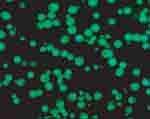Producing immunoglobulins in plants could yield gram quantities of these precious proteins.
Producing antibodies in plants could yield gram quantities of these precious immune proteins, report researchers. Yuri Gleba at German biotech firm Icon Genetics, together with collaborators in Belgium, have developed a way to produce molecules of the antibody class immunoglobulin G (IgG) in the leaves of ordinary tobacco plants.1
Previous attempts to express immunoglobulins in plants relied on genetic modification, which would take more than a year to bear fruit. In this system, the genes for two key components of immunoglobulin molecules - the heavy and light chains - are carried in the genomes of two separate plant viruses. Infecting plants with these viruses led to the production of gram quantities of IgG within two weeks.

One key ingredient of the new recipe is based on the researchers’ observation that certain pairings of viruses can peacefully co-exist in plant cells without harming each other’s ability to reproduce and infect other cells. The researchers used tobacco mosaic virus (TMV) and potato virus X (PVX) as vectors to carry the separate genes for heavy and light chains, and showed that the protein chains recombined to form entire IgG antibodies in the plant leaves. The method generated up to half a gram of functional and specific antibodies per kilogram of fresh leaves, even without major efforts to optimize the yield.
Andreas Pl?ckthun, a veteran of antibody biotechnology, now at the University of Zurich, Switzerland, praised the new approach: ’This very elegant method could potentially be of interest as an alternative production method, if it becomes economically attractive,’ he told Chemistry World. Pl?ckthun noted, however, that correct glycosylation is needed for antibodies to carry out physiological functions in the human body. ’IgGs produced in plants will normally not be able to bind to Fc receptors [which antibodies use to bind to cells], because the plant glycosylation usually prevents this, as does the unglycosylated form described by the authors.’ This could limit the applicability of such plant-produced antibodies, he warned.
But Gleba, who did the work, says many research applications don’t need glycosylated antibodies. For any medical applications that require the human-type gycosylation pattern, he is confident that this can be achieved in plants. ’Different groups of scientists have made successful steps in genetic modification of various organisms (yeast, insect cells, plant cells) to generate hosts with more "humanized" glycosylation,’ said Gleba.
The work impresses Merardo Pujol, who leads a group investigating expression of antibodies in plants2 at the Centre for Genetic Engineering and Biotechnology in Havana, Cuba. ’I think it’s a quite outstanding development, which boosts the potential of plant expression systems for antibodies and multimeric proteins,’ Pujol said.
Michael Gross
The fate of the prey captured by our body’s guardian antibodies can be determined by sugar molecules found on the antibody’s surface.
References
et al,Proc. Natl. Acad. Sci. USARodríguez et al, 2005, Biotechnology and Bioengineering, 89, 188






No comments yet